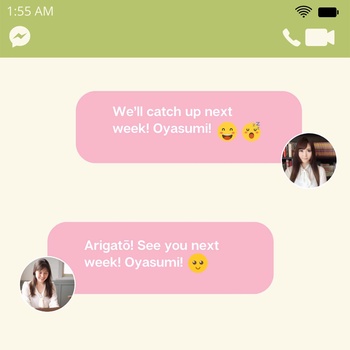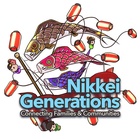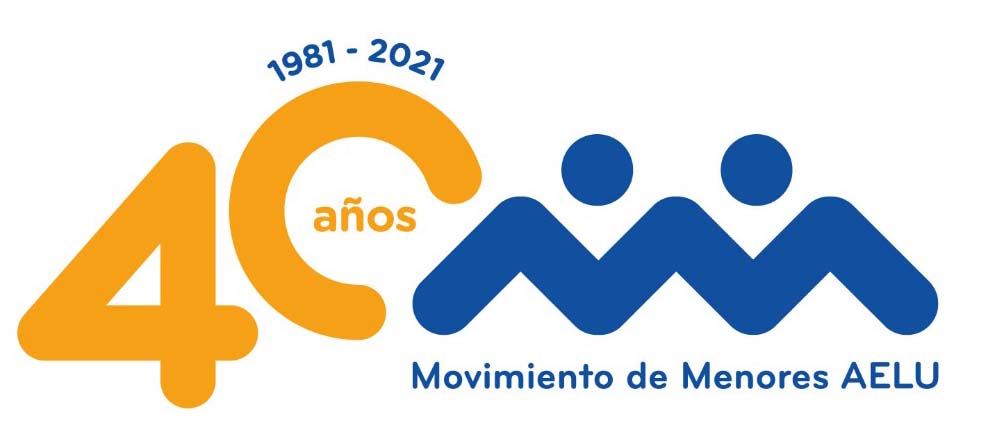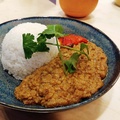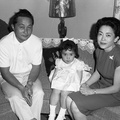「じゃまた来いよ! 」
"また後で!"
Zoom通話が終了し、ようやくベッドへ向かいます。
私たち二人にとってまた長い一日が過ぎました。会議、締め切り、授業。お疲れ様!
ベッドに横たわり、頭上の暗い深淵を見つめながら、その日がどうだったか、明日のために何を準備する必要があるかを振り返ります。
どのようにしてここまで来たのでしょうか。ここで言う「ここ」とは、Japanese for Nikkei の共同設立者となり、言語学習者が成長できる日系スペースを作ることの重要性を訴えようとしていることです。私は長い間、アジア文化全般、特に私の日本人としてのアイデンティティ、言語、文化に関係するあらゆることとはまったく逆の方向に走ろうとしてきました。
いつもこうだったわけではないことを覚えています。土曜日の学校が楽しかった時期、「日本人」の人たちと過ごすのがまったく普通に感じられ、自分自身にもっと自信と心地よさを感じていた時期もありました。それはいつのことだったでしょうか、中学の頃でしょうか。いいえ、おそらくすべては幼稚園の頃から始まったのでしょう。みんなが私に優しくしてくれたにもかかわらず、私は自分があまり馴染めないことを知っていました。私はクラスの誰とも似ておらず、私の名前を誰も発音できませんでした。ツナミ、スズキ、スシ。でも、私は気にしていませんでした。私はただクスクス笑いながら、スカートに落ちたおせんべいのパンくずのようにそれを払いのけていました。
おせんべいといえば、家でこっそり食べられるおやつのひとつでした。でも、ガッシャーズやフルーツロールアップのようなおしゃれなおやつを持っていないとからかわれるのが怖くて、学校に持って行く勇気はありませんでした。
私は寝返りを打ち、ベッドの周りで携帯電話を探した。Facebook のフィードをスクロールし、サチにメッセージを送ることにした。
サチさん!今日はありがとう!ところで、まったくランダムな質問ですが:
おせんべいのような日本のお菓子を学校に持ってきましたか?それともコアラのまち?
* * * * *
お疲れ様。メールからログアウトして、もう寝ることにしました。正直、普段は寝るのが好きではないのですが、私の小さなウサギがいればすべてがうまくいきます。暗闇の中で、彼女は床から私を見て、私はベッドから彼女を見ています。
彼女は救助された。いや、私が救助されるんだ。
「おやすみ、かぼちゃ。」
夜のためにくつろぐ準備をするため、バスルームへ向かいます。蛇口をひねり、両手をカップ状にして適温になるまで待ちます。両手のひらに水がたまる中、顔を上げて鏡に映った自分の姿を眺めていると、頭の中にさまざまな考えが浮かんできます。
私はいつも、内面で感じるよりも見た目が白いのですが、それについてはどうしようもありません。どこにも馴染めませんが、それを受け入れるようになりました。「半分だけ」日本人であるということは、言語と文化のバランスが取れていないことを意味します。トロントで出会った混血の人の多くは、英語以外の言語が多少流暢に話せる程度で、日本で出会った混血の人のほとんどは、日本語以外の言語でほとんどコミュニケーションが取れませんでした。
わかります。難しいことです。本当に難しいことです。私の人生の大きな目標の 1 つは、そうした固定観念を打ち破り、あらゆる面で可能な限りバランスをとることです。私はこれまで、日本人でもカナダ人でもないことがよくありましたが、両方になることが可能であることを世界に示すためにここにいます。
ようやくお湯が希望の温度になりました。顔に水をかけて歯を磨いてからベッドへ向かいます。
時間を確認するために机から携帯電話を取り出します。
ん?またつぐみからのメッセージ?私はこう返信する。
私は日本のお菓子が大好きですが、学校に持って行ったことはありません。
普段は日本に来た時にしか食べませんでした!
おやつ、というか食べ物全般について言えば、私の父は料理が上手です。父の作る食事はどれも特別なものになります。おそらくいつも日本食だからでしょう。私が物心ついたころからずっとそうでした。私はいつも日本食を食べるのが好きでしたが、家の外で食べるのは、いつも違ったものでした。
今では、多くの人がさまざまな日本料理について知っていますが、私が小学校に通っていた頃(当時は白人が多い学校でした)は、状況は大きく異なっていました。「それは何?」「うわっ」というコメントや、学校が終わる頃には食べられないほどになっていた昼食を食べなかったことで母に叱られたことを今でも覚えています。
* * * * *
サチから返事が来たので、入力し始めます。
言いたいことはわかります!以前、ランチにカツサンドを持って行ったとき、ハムとチーズじゃなかったからみんなびっくりしたのを覚えています。
時々、人種差別との遭遇に関して、物事がどれほど変わったのか疑問に思う。残念ながら、人種差別は多様で、多くの場合、子供の頃に経験し、文化的誇り、価値観、関心を少しずつ削り取り、侵食し、私たちのかつての姿の殻だけが残る。学校では、寿司を食べることは「気持ち悪い」と考えられていたことを覚えている。彼らは、「私たちは食べ物を調理して食べるのが好きなんだ」などと言っていた。
今では、お寿司は人気で、父の商売にとっても良いことだと思います。あの子たちも今ではお寿司を食べているのでしょうか?このような経験は、どんな食べ物なら食べてもいいか、どんな食べ物はダメかという私の認識に、ずっと影響を与えています。私が若い頃は、おにぎりやお寿司を食べることは恥ずかしく、恥ずかしいことでした。長い間、日本食が嫌いなふりをしていたと思いますが、今ではよく作って食べています。
最悪なのは、日本人の仲間が私を日本人らしくない(それが何を意味するかはともかく)と責め立てようとするときです。サチのように、私は二つの文化の間で育ち、二つの世界を行き来していますが、どちらにも着地するのが難しいと感じることがよくあります。
それで、先ほどの質問に戻りますが…
私たちが今日、日系人のための日本語を創刊できたのは、私たちの個人的な経験が、私たちの伝統文化とのつながり方を形作り、形づくってきたからです。私たちが抱えるフラストレーションと相反する感情、不安が、日系人のための日本語を創刊するきっかけとなりましたが、私たちは、人々がもう一度日本語に挑戦してくれることを願って、その否定的な感情を肯定的な感情に変えました。なぜなら、学ぶのに遅すぎるということはないからです。
Japanese for Nikkei を始めたことで、私たちは独自のコミュニティを作り始めました。そこには、世界中の人々が日本語を流暢に話せるようになるという共通の目標のために集まります。そのため、私たちのコミュニティは、世代間の分断を感じたり見たりする他のコミュニティとは異なります。今日の午後、私たちはふわふわパンケーキで JFN の 1 周年を祝いました。今後ももっとたくさんのパンケーキが食べられるといいですね。
さて、食べ物の話ばかりしていたらお腹が空いてきました。そろそろ本気で寝る時間です。
来週また会いましょう!おやすみ!
ありがとう!また来週!おやすみ!
© 2021 Mimi Okabe, Sachi Kikuchi



